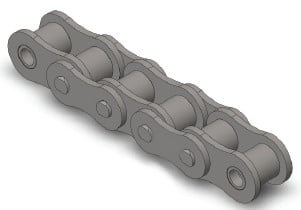The next ways should really be utilized to pick chain and sprocket sizes, figure out the minimum center distance, and calculate the length of chain necessary in pitches. We’ll principally use Imperial units (such as horsepower) in this segment even so Kilowatt Capability tables are available for each chain dimension in the preceding segment. The choice technique could be the similar irrespective of your units used.
Phase one: Ascertain the Class in the Driven Load
Estimate which on the following ideal characterizes the ailment of your drive.
Uniform: Smooth operation. Little or no shock loading. Soft get started up. Moderate: Standard or moderate shock loading.
Heavy: Significant shock loading. Regular starts and stops.
Phase two: Figure out the Services Issue
From Table 1 under establish the appropriate Services Element (SF) for that drive.
Stage three: Determine Layout Power Necessity
Style and design Horsepower (DHP) = HP x SF (Imperial Units)
or
Style and design Kilowatt Power (DKW) = KW x SF (Metric Units)
The Design Energy Requirement is equal for the motor (or engine) output energy times the Services Component obtained from Table 1.
Stage 4: Create a Tentative Chain Assortment
Produce a tentative choice of the necessary chain size inside the following method:
one. If employing Kilowatt power – fi rst convert to horsepower for this step by multiplying the motor Kilowatt rating by 1.340 . . . This really is required because the brief selector chart is shown in horsepower.
two. Locate the Style and design Horsepower calculated in phase 3 by reading up the single, double, triple or quad chain columns. Draw a horizontal line via this value.
three. Locate the rpm of your smaller sprocket within the horizontal axis of the chart. Draw a vertical line via this worth.
4. The intersection from the two lines must indicate the tentative chain choice.
Step 5: Decide on the quantity of Teeth for your Modest Sprocket
After a tentative choice of the chain dimension is produced we have to determine the minimal number of teeth needed around the modest sprocket needed to transmit the Layout Horsepower (DHP) or the Design and style Kilowatt Electrical power (DKW).
Stage six: Determine the amount of Teeth to the Massive Sprocket
Utilize the following to calculate the number of teeth to the substantial sprocket:
N = (r / R) x n
The amount of teeth within the significant sprocket equals the rpm of the smaller sprocket (r) divided from the preferred rpm in the big sprocket (R) occasions the number of teeth around the tiny sprocket. If your sprocket is too big to the space obtainable then numerous strand chains of the smaller pitch should really be checked.
Phase 7: Figure out the Minimal Shaft Center Distance
Make use of the following to calculate the minimal shaft center distance (in chain pitches):
C (min) = (2N + n) / six
The above is actually a guide only.
Step eight: Test the Final Variety
In addition bear in mind of any potential interference or other area limitations that could exist and modify the choice accordingly. Generally one of the most efficient/cost eff ective drive makes use of single strand chains. This is often mainly because various strand sprockets are extra highly-priced and as can be ascertained from the multi-strand aspects the chains come to be significantly less effi cient in transmitting power because the number of strands increases. It can be therefore commonly finest to specify single strand chains whenever achievable
Step 9: Ascertain the Length of Chain in Pitches
Make use of the following to determine the length on the chain (L) in pitches:
L = ((N + n) / two) + (2C) + (K / C)
Values for “K” could be discovered in Table 4 on page 43. Don’t forget that
C will  be the shaft center distance offered in pitches of chain (not inches or millimeters and so on). If your shaft center distance is identified in a unit of length the worth C is obtained by dividing the chain pitch (in the similar unit) through the shaft centers.
be the shaft center distance offered in pitches of chain (not inches or millimeters and so on). If your shaft center distance is identified in a unit of length the worth C is obtained by dividing the chain pitch (in the similar unit) through the shaft centers.
C = Shaft Centers (inches) / Chain Pitch (inches)
or
C = Shaft Centers (millimeters) / Chain Pitch (millimeters)
Note that every time probable it can be ideal to employ an even number of pitches so as to prevent the usage of an off set link. Off sets will not possess the same load carrying capacity since the base chain and ought to be averted if achievable.
WE OFFER Agricultural gearboxes AND OTHER Agricultural PRODUCTS. Mail us: [email protected]
